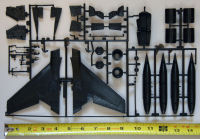
Monogram 1/48 RF-101B Voodoo Kit Second Look
By Sundiata Cowels
| Date of Review | September 2012 | Manufacturer | Monogram |
|---|---|---|---|
| Subject | RF-101B Voodoo | Scale | 1/48 |
| Kit Number | 5818a | Primary Media | Styrene |
| Pros | Only RF-101B in this scale to date | Cons | Out of Production |
| Skill Level | Basic | MSRP (USD) | Out of Production |
First Look
 |
 |
 |
 |
 |
Originally conceived in 1946 as a long range penetration fighter for the Strategic Air Command to escort Convair's massive B-36 bomber, the McDonnell Aircraft Company XF-88 – a swept wing, dual turbojet aircraft – was ultimately cancelled and redesigned as the F-101 Voodoo to fulfill requirements for the then newly formed Tactical Air Command.
With a maximum speed of 1,220 mph (1,963 kph) at 40,000 ft (12,192 meters) and 716 mph (1,152kph) at sea level, the Voodoo was well equipped to evade most dangers while conducting its mission. As such, the "One-Oh-Wonder", in its recon configuration, is reputed to have flown some of the fastest reconnaissance sorties over North Vietnam prior to the introduction of the SR-71 Blackbird.
While the single-seat RF-101C went on to provide pathfinder and tactical reconnaissance for strike packages during the Vietnam War, the RF-101B was actually modified from 23 ex-Royal Canadian Air Force F-101Bs by Martin Marietta and Ling-Temco-Vought to provide daylight reconnaissance for the Air National Guard, in an ongoing effort to keep it up-to-date during the Cold War era. All armament and fire control systems in the original configuration were removed and the nose was modified to house the cameras and control equipment. Communications and navigation gear were relocated to the now vacant weapons bay. Although a second seat is visible in photos of the RF-101B, research suggests that the rear seat was unoccupied and only the front seat was utilized by the pilot. The Voodoo went on to serve with the Air Forces of Canada and Taiwan in addition to the US Air Force and Air National Guard.
After a spate of three consecutive floods that depreciated the value of my scale model collection considerably, I decided to take the time to salvage the few kits that I had left. Among these was Monograms' RF-101B Voodoo (kit 5818). As with most Monogram kits of that period, it comes in the standard top opening cardboard box with a stylish cover art of the aircraft in question, overlapping a cutout of a stylized blue sky bound within a yellow bordered frame.
The kit itself is styrene, molded in a dark olive drab color on four trees with a fifth for clear styrene canopy and camera window pane parts. First impressions are very good and this should build into a nice kit. There is some flash on the trees but thankfully, not on the actual model parts.
Monogram pulled out all of the stops on this kit. It includes: intake ducting, turbine faces, detailed wheel bays, multi-part ejection seats, multi-part burners, pilot figures, multi-part canopy, flaps and speed brakes, and clear plastic for the recon nose windows. As mentioned above, the crewman for the back seat shouldn't be installed, contrary to the instructions and box-art.
Perfectionist will decry the lack of a film camera system (two KS-87B vertical cameras and AXQ-2 downward and forward looking cameras) behind the "glass", but these could be scratch built with a creative use of spare parts. Additional after-market resin detailing can be sourced from Koster Aero Enterprise and Legend Productions for single-seat conversions to RF-101C standard and electronic bay add-ons respectively.
A federal standard color chart (FS 595a) is listed for the suggested Monogram-Humbrol enamel paints along with the requisite camouflage layout three-way drawing that is included on the fold out instruction sheet.
According to the instructions, the kit decals depict a RF-101B of the Air National Guard 192nd Tactical Recon Squadron in a four-color Tactical Air Force camouflage design. Further research reveals that the 192nd was stationed in Reno Nevada 1971-1975 and did not rotate overseas. Beyond that, very little is available regarding specific aircraft. By the end of 1975, the limited number of converted airframes and the complexity of the electronics made the RF-101B too expensive to maintain and they were eventually phased out from active service as the unit transitioned to the RF-4C Phantom II.
The decals were damaged in the aforementioned flood; they appear to offer the most basic of insignia and stencils; a good after market stencil sheet would do wonders.
Until Revell re-releases this kit or someone like Kinetic or Hobby Boss/Trumpeter make their own tooling (how about the single seat RF-101C, hint, hint, wink, wink), I think this about the only version of this aircraft released in this scale and it should make a very good kit out-of-box.
If you happen to find one at your next local IPMS convention, buy one for me as well.







